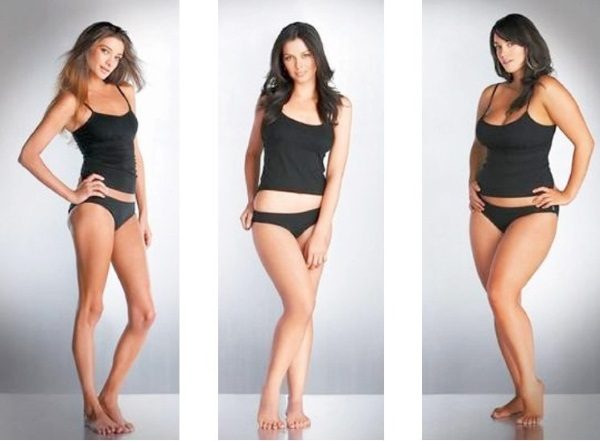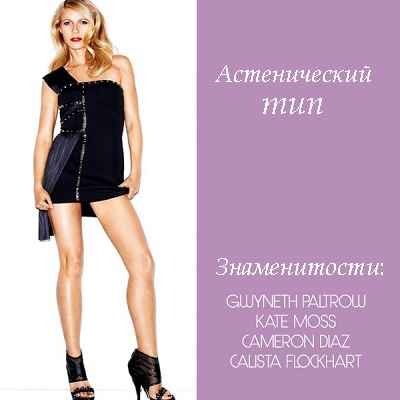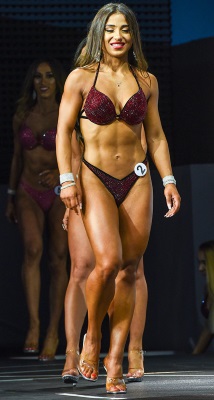With skillful use of the advantages of her physique, any woman will feel confident and attractive, and for the correct selection of diet, physical activity and everyday image, it is enough to learn how to determine her body type and know the allowable weight limit to be adhered to.
Types and types of physique
Body types in women are determined on the basis of a genetically formed somatotype (a set of properties and characteristics of the body, laid down at birth).
If the figure (the term means the outlines of the body) can change under the influence of external factors and the way of life, then the somatotype is a constant value, on the basis of which the appearance of the figure is laid. Therefore, these concepts are not equivalent and are fundamentally different.
The most common is the classification of the female physique, used in Russian medical practice, into 3 types:
- asthenic (thin);
- normosthenic (proportional);
- hypersthenic (broad-boned).
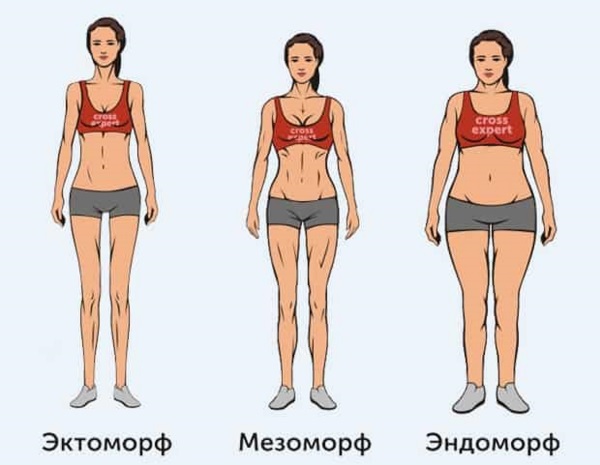
There are quite a few typologies of the physique of the female body in the literature, and they are based on various classification signs. In fact, most of them have similarities, and some concepts are often synonymous with others.
| Theorist | Classification attribute | Body type |
| V. N. Shevkunenko | By anatomical features (by measuring individual body parts and their proportions). |
|
| E. Kretschmer | Taking into account the psycho-emotional characteristics and physique. |
|
| W. Sheldon | By morphological features (visual assessment of body type). |
|
| M.V. Chernorutsky | According to the structural features of the skeletal system and muscle tissue. |
|
| V.P. Petlenko | According to the structural features of the skeletal system and muscle tissue (a more expanded interpretation). |
|
| K. Seago | According to the prevailing system of organs with pronounced dominant signs (respiration, digestion, nervous, muscular-muscular). |
|
| I. B. Galant | According to body composition, taking into account the level of development of muscle tissue and body fat, basic proportions. |
|
To determine your body type (according to the main classification), it is enough to measure the circumference of the wrist at the thinnest place. The resulting value is a characteristic of the thickness of bone tissue, on the basis of which this typology is built. At the same time, the measurement indicators for women and men will differ.
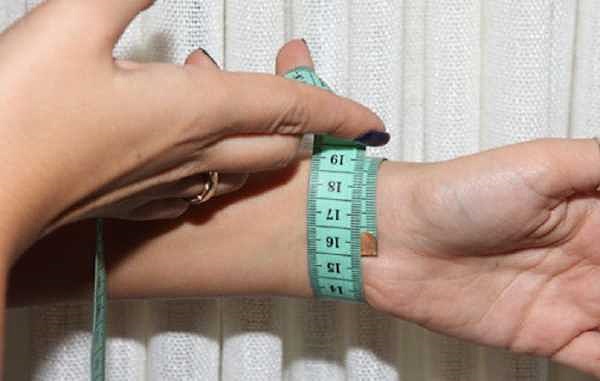
- Normostenics - within 15 - 17 cm (and 18 - 20 cm in men).
- Asthenics - less than 15 cm (and 18 cm in men).
- Hypersthenics - over 17 cm (and 20 cm in men).
This is the easiest, but also the most imprecise way to establish your somatotype. In practice, there are several dozen formulas for determining a woman's belonging to a particular body type (including online calculators). Most of them take into account the proportion of height and weight.
So M.V. Chernorutsky proposes to carry out a classification of physique based on weight, height and chest coverage according to the Pignet formula.
Pignet index = Height - (weight + chest coverage)
For the calculation, measurements are used in centimeters and kilograms. The resulting number has the following interpretation:
- for asthenics - more than 30;
- for normosthenics - from 10 to 30 (inclusive);
- for hypersthenics - less than 10.
So, if a woman's weight is 50 kg with a height of 170 cm and a chest circumference of 90 cm, the indicator will be:
- PI = 170 - (50 + 90) = 30
Accordingly, it belongs to the normosthenic type.
Asthenics (ectomorphs)
Body types in women, distinguished by fragility and harmony, are referred to as the asthenic type, which combines synonymous concepts under its name: ectomorphs, hyposthenics. This also includes a graceful physique. Such women are often called thin-boned women.
They are characterized by the following body features:
- poorly developed muscle mass;
- tall (optional);
- elongated and most often cold limbs;
- small breast size;
- thin and slightly elongated facial features;
- thin skin and hair;
- narrow shoulders.
The small body weight of women with asthenic physique is associated with an accelerated metabolism. Hence the symptoms of cold extremities, a love of sweets and a need for complex carbohydrates.
Body type affects the characteristics of a woman's character. Ectomorphs differ:
- resentment and secrecy;
- fatigue and an increased sense of anxiety;
- vulnerability and insecurity;
- a tendency to depression.
Hyposthenics - people with poorly developed muscles, who have a predisposition to frequent diseases:
- colds (often with complications);
- diseases of the respiratory and digestive organs;
- heart disease, hypotension and neuroses.
Hypersthenics (endomorphs)
The complete opposite of the asthenic type. Hypersthenic women are distinguished by large body shapes, which is why this somatotype is also called a picnic, broad-boned or endomorphic.

- short or medium height;
- tendency to corpulence;
- wide waist, hips and bust;
- feminine rounded shapes and the presence of a tummy;
- large breast size;
- endurance.
A common problem with hypersthenics is the fight against excess weight. Women's metabolism is slowed down, weight is easy to gain and difficult to lose. Therefore, it is recommended to give preference to protein foods in the diet.
Distinctive character traits:
- kindness and a tendency to forgive everything;
- longsuffering and phlegmatism;
- openness and non-conflict.
People with similar qualities are often called a person with a wide soul and a big heart. They remain outwardly calm even in stressful situations, and slowness is an integral character trait. Endomorphs are characterized by physical and emotional endurance. The presence of excess body fat puts additional stress on the body.
Among the diseases of this type of physique prevail:
- endocrine system diseases, obesity;
- respiratory and liver diseases;
- heart disease and hypertension.
Normostenics (mesomorphs)
The normosthenic somatotype occupies a middle position between the two previous extremes in the typology of the female body. It is distinguished by its harmonious proportions and well-developed muscles.

- average height (most often);
- pronounced waist;
- shoulder width approximately equal to or slightly more than hips;
- tightened appearance and elastic skin;
- normal metabolism;
- the correct ratio of body parts.
It is easy for women with a mesomorphic physique to gain weight and then lose it. They are confident in themselves and their appearance, and therefore are often overly proud of themselves.
Among the character traits prevail:
- purposefulness and leadership qualities;
- activity and impetuosity;
- quick response and decisiveness.
Normostenics are less susceptible to diseases, among which the most common are:
- diseases of the respiratory system and digestive tract;
- colds;
- diseases of the musculoskeletal system and hypertension.
Athletic body type
Corresponds to the normosthenic type, being part of it according to some theories.
Among women, it is rare and different:
- above average growth;
- elongated limbs;
- well-developed muscle mass;
- narrow hips and broad sternum;
- massive bone skeleton;
- endurance and fit.
Women of athletic somatotype appear large, but not plump. Facial features are sharp and angular.
They have a strong-willed and decisive character, are confident in themselves and adhere to an active life position. Usually such people are called heroes.
Cerebral (cerebral) physique
According to the theory of K. Sego, this type of physique can be attributed to women whose professions are associated with mental activity: scientists, philosophers, teachers, analysts, lawyers, economists.
They are characterized by:
- tendency to thinness;
- short stature;
- poorly developed muscle mass;
- large head size in relation to the body;
- narrow hips and shoulders;
- high forehead and small facial features.
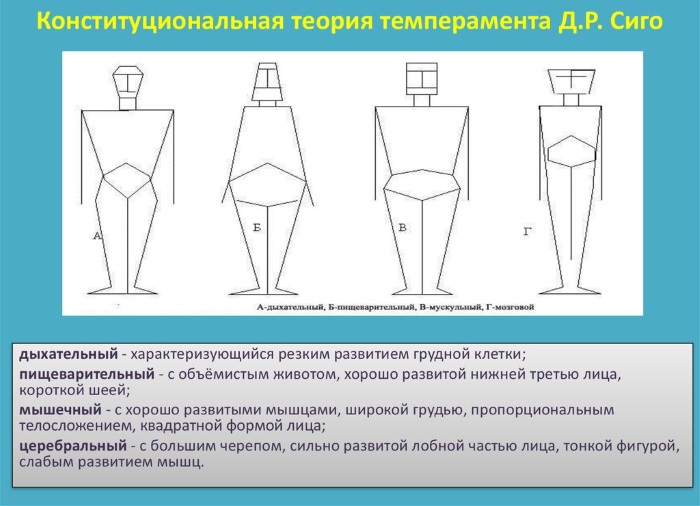
Respiratory physique
Respiratory women have wide tops and narrow bottoms. Most often, this type is found in athletes (athletes, swimmers, runners).
Distinctive features of the respiratory somatotype:
- growth above average;
- large chest circumference and development of the respiratory system;
- pronounced waist and narrow pelvis;
- broad shoulders;
- elongated sternum and limbs;
- large facial features associated with respiratory stress (nose, cheeks).
The owners of such a physique are energetic and hardy, with sharp facial features and the same sharp character and impetuosity.
Digestive physique
According to external signs, it corresponds to a hypersthenic physique, and is characterized by:
- a tendency to obesity;
- the presence of a stomach and a shortened chest;
- soft facial features with a wide jaw and lips;
- broad-boned body structure;
- full limbs with poorly developed muscles.
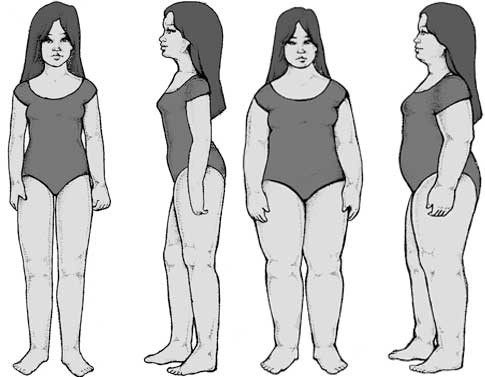
Dysplastic physique
Assumes the presence of visible defects and inconsistencies in body proportions (asymmetry of the limbs, congenital deformities of the skeleton). In this case, physique features appear at birth or during the first few years of life.
Diseases acquired in the process of vital activity (diseases of the skeletal system and musculoskeletal system, severe scoliosis, muscle atrophy) or imbalances resulting from mechanical factors (injury, injury) are not an indicator of the dysplastic somatotype and do not affect its change.
People with such physique features are characterized by secrecy, solitude, silence.
Mixed physique
Body types in women, presented in the generally accepted classification of 3 types (hypersthenics, asthenics, hyposthenics), are the extreme points of diametrical differences. However, in life, many women do not fall under the absolute description of this or that somatotype, and the boundaries between them are conditional.
In this case, a mixed body type is meant:
- ectomorph-mesomorph;
- ectomorph-endomorph;
- endomorph-mesomorph.
The classification focuses on the main characteristics of the physique that prevail in a particular somatotype. For example, a woman with a narrow chest, thin facial features, a small breast size, a pronounced waist and the presence of excess fat deposits in the gluteal region (in sharp contrast to the top) belongs to the ectomorph-endomorph type.
Weight index
Determination of the woman's weight index or body mass index (abbreviated as BMI) makes it possible to assess the correspondence of the main anthropometric parameters of a woman - height and body weight - and to determine the need for weight correction by changing the diet or physical activity.
In general, the formula for calculating the mass index is:
BMI = M / H2,
Where:
- M - weight, kg;
- Н2 - height in meters, taken in a square.
For example, if a woman is 1.7 m tall and weighs 50 kg, then:
BMI = 50 / (1.7 x 1.7) = 17.
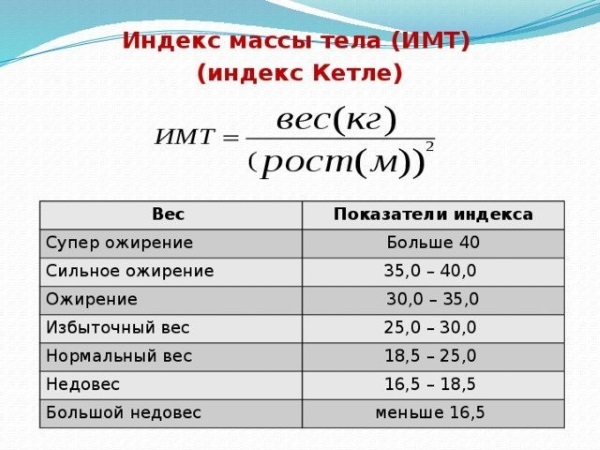
- up to 16 kg / sq. m - pronounced deficit weight;
- from 16 to 18.5 kg / sq. m - deficient weight;
- from 18.5 to 25 kg / sq. m - weight within normal limits;
- from 25 to 30 kg / sq. m - there is a tendency to obesity;
- from 30 to 35 kg / sq. m - the presence of obesity;
- from 35 to 40 kg / sq. m - high degree of obesity;
- from 40 kg / sq. m and more - a pronounced, sharp form of obesity.
Accordingly, the resulting value is 17 kg / sq. m falls under the indicator of deficit weight.
This formula has large errors and does not take into account the peculiarities of a particular somatotype, which can significantly go beyond the preset BMI values.
Height and weight standards by body type
Body types in women have their own characteristics and distinctive features, on the basis of which the ideal weight norm for each somatotype is determined. Moreover, this rate may vary depending on the age of the woman.
| Height, cm | Allowable weight, kg | ||
| for asthenics (ectomorphs) | for normostenics (mesomorphs) | for hypersthenics (endomorphs) | |
| Up to 148 | 42,5 – 51,2 | 45,3 – 54,9 | 53,4 – 60,0 |
| 148 – 150 | 43,2 – 52,2 | 49,8 – 57,4 | 54,6 – 62,4 |
| 151 – 153 | 44,7 – 52,6 | 51,2 – 57,2 | 53,8 – 62,7 |
| 154 – 159 | 47,2 – 56,3 | 52,1 – 61,3 | 56,4 – 65,8 |
| 160 – 163 | 50,9 – 57,4 | 54,8 – 68,2 | 58,8 – 68,7 |
| 164 – 169 | 52,9 – 61,0 | 57,4 – 65,6 | 62,2 – 72,4 |
| 170 – 173 | 55,6 – 63,1 | 60,2 – 68,3 | 65,1 – 75,7 |
| 174 – 179 | 57,1 – 65,6 | 62,4 – 71,1 | 66,6 – 78,4 |
| 180 and more | 61,2 – 68,7 | 65,3 – 73,6 | 69,7 – 81,6 |
These indicators are suitable for the category of women aged 18 to 35 years. If the age is greater, then you need to add to the indicated values:
- 3 kg for ectomorphs;
- 4 kg for mesomorphs;
- 5 kg for endomorphs.
In this case, the norm means the average value of the mass, which can fluctuate in the region of the segment between the limiting points of the maximum and minimum, and differ depending on the used formulas for calculating the ideal weight.
The classic formula for determining BMI, taking into account the somatotype
The formula for calculating BMI, recommended by the World Health Organization, has been refined over time and takes into account the somatotype of women.
It looks like:
- for asthenics BMI = (M + 10%) / H2;
- for normosthenics BMI = M / H2;
- for hypersthenics (M - 10%) / H2.
Thus, in the presence of hypersthenic or asthenic physique, preliminary correction of body weight by 10% in the direction of decrease or increase, respectively, is required.
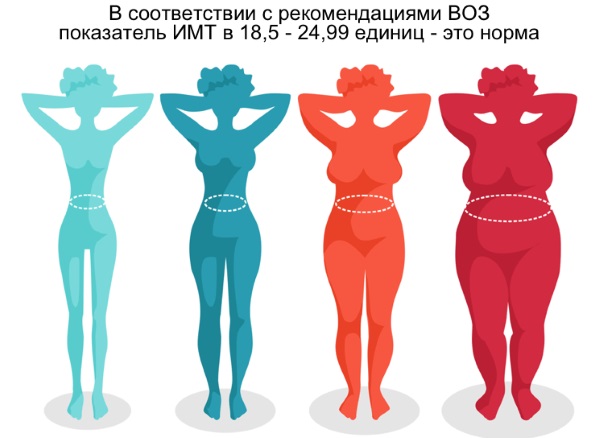
- The woman has an asthenic somatotype with a mass of 47 kg and a height of 162 cm.
BMI = (47 + 10%) / (1.62 x 1.62) = (47 + 4.7) / 2.6244 = 19.7
Accordingly, the weight is within the normal range (according to WHO).
- The woman has a mesomorphic somatotype with a mass of 63 kg and a height of 168 cm.
BMI = 63 / (1.68 x 1.68) = 63 / 2.8224 = 22.3
Which corresponds to the normal weight.
- A hypersthenic woman weighing 76 kg and a height of 164 cm.
BMI = (76 - 10%) / (1.64 x 1.64) = (76 - 7.6) / 2.69 = 25.4
In this case, there is already a tendency towards obesity.
Weight index according to Broca's formula
The fundamental formula for determining the ideal body weight was developed by the French surgeon P. Broca in the second half of the 19th century.
It looks like this (for women):
IV = Height - 100
For the calculation, take the value of height in centimeters.
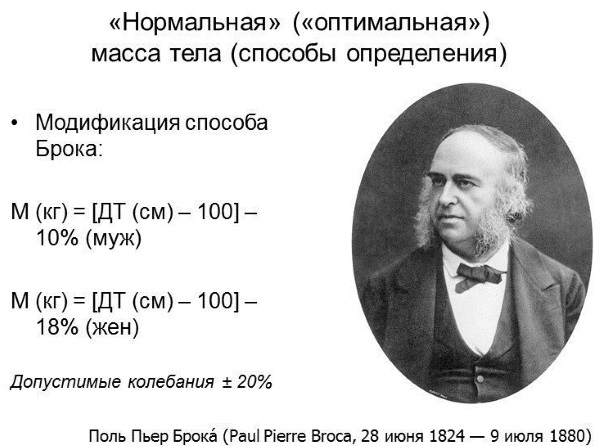
- suitable only for the average woman with a height of 155 cm to 175 cm;
- not suitable for athletes;
- not suitable for women with weight loss or weight gain conditions.
Brock-Brugsch weight index, taking into account physique
The previous formula was finalized by the German scientist T. Brugsch for women whose height does not fit into the interval 155 - 175 cm.
- with growth less than 165 cm IV = Height - 100;
- with a growth of 165 - 175 cm IV = Height - 105;
- with growth over 175 cm IV = Height - 110.
These formulas are suitable for female mesomorphs. With asthenic type, it is recommended to add 10% to the resulting IV, and with hypersthenic type, subtract 10% from the result.
For instance:
- The woman has a normal (mesomorphic) physique with a height of 167 cm.
IV = 167 - 105 = 62 kg - ideal body weight.
- With an asthenic constitution with the same height:
IV = (167 - 105) - 10% = 62 - 6.2 = 55.8 kg - ideal weight.
- With a hypersthenic somatotype and a height of 162 cm in a woman:
IV = (162 - 100) + 10% = 62 + 6.2 = 68.2 kg.
Quetelet index taking into account physique and age
According to A. Quetelet, 1 cm of a woman's height accounts for a certain amount of weight, which varies depending on the somatotype and age. The formula assumes the calculation of the ideal weight for women of reproductive age from 15 to 40 years.
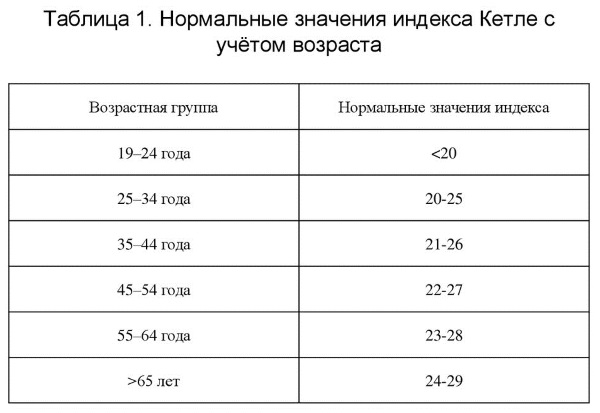
- IV = K x Height,
where K is the weight coefficient in grams per cm, determined from the table.
| Age, years | Weight per cm of height, g | ||
| Asthenic | Normosthenic | Hypersthenic | |
| 15 – 18 | 315 | 325 | 355 |
| 19 – 25 | 325 | 345 | 370 |
| 26 – 39 | 335 | 360 | 380 |
If you are less than 160 cm tall and under the age of 20, it is recommended to reduce the result obtained by 10%.
For instance:
- The normal weight for a woman with a height of 170 cm and an age of 30 years with a hypersthenic physique will be the value:
IV = 380 x 170 = 64600 g or 64.6 kg.
- The ideal weight for a 17-year-old girl with a height of 165 cm and an asthenic body type will be:
IV = 315 x 165 - 10% = 46.8 kg.
Humvee Formula
A popular way to determine the ideal weight is calculated in inches and looks like (for women):
IV = 45.5 + 2.2 x (Height - 60)
She suggests that the optimal weight for a 60-inch (152.4 cm) woman is 45.5 kg. If a woman is more than 60 inches tall, then for every additional 1 inch there is 2.2 kg of mass.
For a better understanding, you can translate the formula into the usual centimeters, based on the generally accepted values of 1 inch = 2.54 cm.It turns out that for every 1 cm of growth (if it exceeds 152.4 cm) there is 2.2 kg / 2.54 cm = 0.87 kg mass.
The final formula in centimeters will look like this:
IV = 45.5 + 0.87 x (Height - 152.4)
This option is suitable for calculating the ideal weight with a normosthenic physique. If a woman is an asthenic, then 10% must be subtracted from the result obtained, and if a hypersthenic, then 10% must be added to the total.
for instance:
- A woman with a height of 165 cm has an asthenic body type.
IV = (45.5 + 0.87 x (165 - 152.4)) - 10% = 51 kg.
- The woman is 170 cm tall and belongs to the mesomorphic somatotype.
IV = 45.5 + 0.87 x (170 - 152.4) = 60.8 kg.
The ideal weight of a woman is a rather vague and conditional concept, for the calculation of which many formulas have been invented. At the same time, not all of them take into account belonging to a certain type of physique and are calculated only on the basis of 1 - 2 values, which is why large errors arise.
Information about the permissible weight norm and knowledge of your somatotype allows you to correct your appearance, work out problem areas of the figure, determine the correct lifestyle and prevent the occurrence of many diseases.
Article author: Anna Lalochkina
Article design: Svetlana Ovsyanikova
Video on the topic: body types of women
Three body types:

